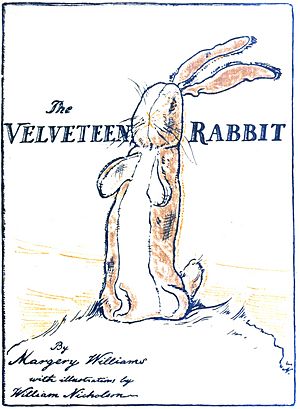The Velveteen Rabbit facts for kids

Front cover of the 1922 Heinemann edition
|
|
| Author | Margery Williams |
|---|---|
| Illustrator | William Nicholson |
| Country | United Kingdom |
| Language | English |
| Genre | Children's novel |
| Publisher | George H. Doran Company |
|
Publication date
|
1922 |
| ISBN | 0-380-00255-8 |
| OCLC | 3690897 |
| Text | The Velveteen Rabbit at Wikisource |
The Velveteen Rabbit, also known as How Toys Become Real, is a famous British children's book. Margery Williams wrote the story, and William Nicholson created the pictures. The book tells the tale of a stuffed toy rabbit. This rabbit deeply wishes to become a real, living rabbit. He learns that a toy can become real through the love of its owner. The story was first published in 1922. It has been printed many times since then.
The Velveteen Rabbit was the first children's book written by Margery Williams. It won the IRA/CBC Children's Choice award. In 2007, the National Education Association held an online poll. Teachers voted this book as #28 on their "Teachers' Top 100 Books for Children" list.
Contents
Story of the Velveteen Rabbit
A new stuffed rabbit, made of soft velveteen, arrives as a Christmas gift. A small boy receives this special present. At first, the boy plays with his other new toys. These toys are modern and mechanical. They do not think much of the old-fashioned velveteen rabbit.
Becoming a Real Toy
The wisest and oldest toy in the nursery is the Skin Horse. He tells the velveteen rabbit a secret. Toys can become real if a child loves them enough. The rabbit is amazed by this idea. He dreams of becoming real, but it seems unlikely.
One night, the boy's nanny gives the rabbit to the boy. The boy needs a toy to sleep with. From that moment on, the velveteen rabbit becomes the boy's favorite. They have picnics together in the spring. The boy truly believes the rabbit is real.
As time passes, the rabbit becomes worn and shabby. But he is very happy. One summer, he meets some real rabbits. They notice he cannot hop like them. They tell him he is not a real rabbit.
A Sad Farewell and New Beginning
One day, the boy gets very sick with scarlet fever. The rabbit stays by his side as he gets better. After the boy recovers, the doctor gives an order. The boy must go to the seaside. His room needs to be disinfected. All his books and toys must be burned. This includes the velveteen rabbit.
The rabbit is put into a sack. He is left outside in the garden overnight. He feels very sad about his life with the boy. A real tear falls from the toy rabbit's eye. Where the tear lands, a beautiful flower appears. A fairy steps out of the flower. She introduces herself as the Nursery Magic Fairy. She comforts the velveteen rabbit. She explains that because the boy truly loved him, he became real to the boy. Now, she will make him real for everyone.
The fairy takes the rabbit to the forest. There, he meets other rabbits. The fairy gives the velveteen rabbit a kiss. The rabbit changes into a real, living rabbit. He joins the other rabbits in the forest. The next spring, the rabbit returns to see the boy. The boy sees a resemblance to his old toy. He enjoys watching the rabbit in the wild.
Velveteen Rabbit Adaptations
The Velveteen Rabbit story has been made into many different films and shows. Here are some of them:
- In 1973, LSB Productions created a 16mm film version. It won several awards.
- The 1976 Rankin/Bass television special The First Easter Rabbit used parts of the book's story. It showed how a toy bunny became the Easter Bunny.
- In 1984, the story was part of the Enchanted Musical Playhouse series. Marie Osmond played the Velveteen Rabbit.
- Rabbit Ears Productions made a video and soundtrack in 1985. Meryl Streep narrated it, and George Winston composed the music. It won a Parents' Choice Award.
- In 1985, two different animated versions were made:
- One was produced in Canada by Atkinson Film-Arts. Christopher Plummer narrated it.
- The other was made by Hanna-Barbera Australia. It aired as an ABC Weekend Special.
- In 2003, Xyzoo Animation made a clay-animated film version.
- In 2007, Horse Fly Studios released a live-action short film. It was nominated for two Young Artist Awards.
- In 2009, Feature Films for Families released a live-action and animated film.
- In October 2015, the Atlantic Theater Company created a new musical version.
- In December 2018, Magic Light Pictures announced plans for a Christmas special. It will combine live-action and animation.
- For many years, ODC/Dance has performed a dance show. It is a narrated contemporary dance version of The Velveteen Rabbit. They often perform it during the holiday season.

